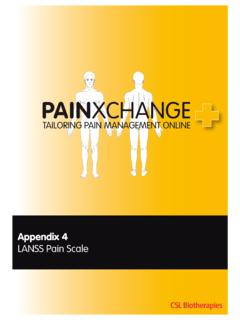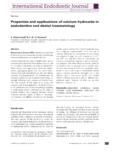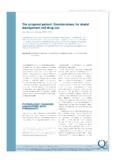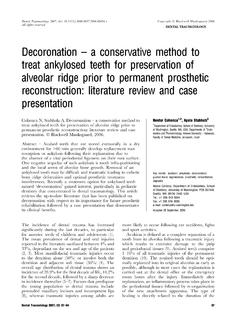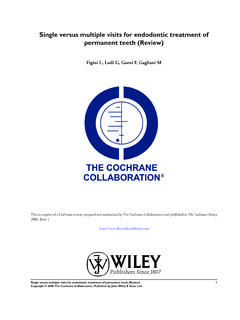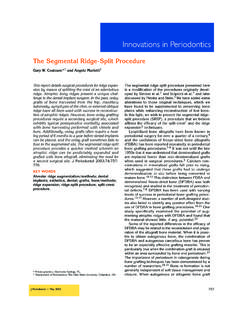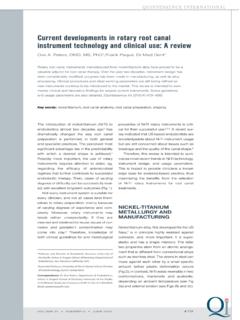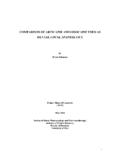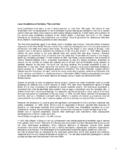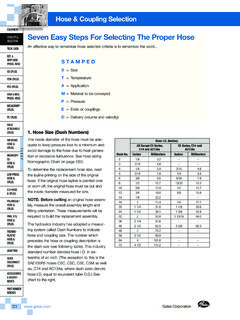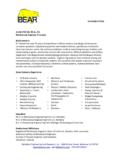Transcription of The thermomechanical properties of gutta-percha
1 The thermomechanical properties of gutta -percha II. The history and molecular chemistry of gutta -percha Alvin Good?na~l, , ,* Herbert Xchilder, , * and Widhrop Aldrich, ,** Boston, Mass. BOSTON UNIVERSITY SCHOOL OF GRADUATE DENTISTRY The various early uses of gutta -percha are reviewed, and its molecular chemistry is discussed. T he early history of gutta -percha is obscure. The Malays and Chinese are said to have used it in a remote and undetermined epoch long before Western civiliza- tion had any knowledge of its , p The recorded evidence of this material in Europe comes from a well-known English family of travelers and curiosity hunters, the Trandescants, in the middle of the seventeeth century. The Trandescants, father and son, were the proprietors of a collection of curiosities assembled near London known as Trandescant s Arc.
2 John Trandescant, the son, published a small book in 1656 entitled Museum I randescantium, or A Cal- lection of Kweties Preserved at South Lambreth Near London. In this book he made the statement : The plyable mazer wood, being warmed in water, will-work to any form. This was thought to apply to gutta -percha since no other material suitable for mazerst was known to possess such properties . Cutta-percha, as for- merly prepared by the natives of Asia, had a yellowish brown color and showed a decidedly fibrous texture. Even experienced observers mistook it for wood. It is interesting that, in the vernacular, one name for the tree that yielded gutta - percha became the mazer wood tree. From a thesis submitted by the senior author in partial fulfillment of the requirements for the degree of Master of Science at Boston University School of Graduate Dentistry.
3 *Instructor, School of Graduate Dentistry. *Assistant Dean, Professor and Chairman, Department of Endodontics. **Assistant Professor, College of Engineering, Boston University. tMazers-Large drinking bowls originally made of hard wood. 954 Volume 37 Number 6 thermomechanical properties of gutta -percha 955 Although Trandescant s Arc ! was a curiosity of its age, frequented by greats, including kings and queens, the unusual properties of the remarkable mazer wood passed quite unnoticed by practical men. After the death of the younger Trandescant in 1662, Elias Ashmole obtained possession of the collec- tion and moved it to Oxford where, in 1682, it became the nucleus of the famed Rshmolean Museum. The historical sample of which young John wrote was never found, but there is little doubt that his mazer wood and gutta -percha are identical For almost 200 years mazer wood was brought into England as a curiosity from the tropical regions of Asia without coming into practical use.
4 In the early 1840 s it was reintroduced into Europe, under the name gutta -percha, in a manner which led to its rediscovery as a valuable substance to be applied in art, science, and manufacturing. - There were two rival claimants for the honor of this reintroduction. Both were residents of Singapore, and both belonged to the medical profession. Dr. Jose D Almeida , 3, 6 brought specimens with him to London in 1843 and presented them to the Royal Asiatic Society. A list of D Almeida s specimens was printed in the Jownal of the Royal Asiatic Society, volume 8, in 1844, in an article entitled A List of Donations to the Museum from April 1842 to June 1844. Dr. William Montgomeriel-G communicated his findings to the Medical Board of Calcutta in 1842 and later to the Society for the Encouragement of Arts, Manufactures, and Commerce in London.
5 Some of the samples and a copy of Montgomerie s letter originally sent to the Medical Board in Calcutta were forwarded to the Agricultural and Horticultural Society of India, where Dr. Fred Mouat, Chemical Examiner to the Governmel of Calcutta, wrote the first published record referring to gutta -percha since th quotation in the Trandescant catalog 186 years earlier. The rediscovery of gutta -percha at that moment in history when dynamic electricity began to play an important role in Western life and the unalterability of gutta -percha in cool water, especially salt water, led to its use in the insulation of telegraph cables. Prior to 1848 many attempts were made to find a suitable insulation for underseas cables, but none of the materials tested could withstand long periods of immersion.
6 The first successful insulation for an underwater line was gutta -percha, used by Ernst Werner von Siemans in 1848. ~ 6 gutta -percha occupied an unrivaled position as the most desirable insulator of electric cables until its replacement by vulcanized rubber late in t,he nineteenth century. People became infatuated with this new material. Patents for its use multi- plied rapidly. gutta -percha was employed for the manufacture of corks, cements, thread, surgical instruments, garments, pipes, and sheathing for ships. Even boats were made wholly of gutta -percha, one as early as 1850. It was constructed by Messrs. Searle and Company of South Lambreth, England, and used in an Arctic expedition. Maps and globes were made of the material, and, because of the thin sheets into which it could be rolled, gutta -percha seemed destined to replace paper.
7 The variety of manufactured articles became bewildering. Musical instruments, candelabra, gaiters, garters, suspenders, window shades, carpets, gloves, mattresses, pillows, tents, umbrellas, and a host of other articles were 956 Goodm(ot, Schilder, and Aldrich Oral surg. June, 1974 Fig. 1. hoprene monomer -3 Isoprene mer. fabricated of gutta -percha. (jutta-percha golf balls were introduced by the later part of the nineteenth century, and until 1920 gutties was the term used for golf balls on links in this country and abroad. Of all these commercial applications, except for its use in golf balls, there remains only a memory, and if it were not for certain special uses, the gutta - percha of Sumatra would have been abandoned hp industry, for the very proper- ties of the material are such that they are opposed to most of the uses to which it was first assigned.))
8 It is an eminently plastic substance at slightly elevated temperatures, and it was not unusual to see garments, as well as slippers, soften with the heat of fire. 1 ulcanization of the chemically related material, rubber, proved much more successful than vulcanization of gutta -percha, and rubber soon dispelled the gutta -percha illusion. It was this characteristic of plasticity of gutta -percha at relatively low tem- peratures that determined the failure of the new industry. As its essential prop- erties became better underst,ood, gutta -percha was left with a less utilized but still significant place in those areas where it could be more suitably ! 3, gutta -percha, the naturally occurring polymer of isoprene, has been known to dentistry for approximately 125 pears,7-!
9 But man s use of such natural polymers antedates recorded history. The science and understanding of polymers is more recent, and only in the last 25 to 30 years has this understanding produced the widespread use of synthetic polymers as we know it today. The characteristic feature of the organic polymer molecule is a chain of cova- lrntly bonded atoms, built by the repetitive chemical linking of small, simple units. The chains are long with molecular weights ranging from lo4 to 106. Their large size and chainlike structure result in fields of attraction between individual molecules (Van der Waals bonding). This bonding, along with nat- ural physical entanglement of the long chains, produces unique and interesting properties in the bulk specimen.
10 Bonding and mechanical interaction of polymer chains vary with the length of the molecule and the orientation and character of its side radicals. Even slight changes in bond orientation of two otherwise identical polymer chains (isomer- ism) result in remarkable differences in mechanical and thermal properties .* Nat,ural rubber and gutta -percha represent, perhaps, the most interesting ex- ample of isomerism. Both are high-molecular-weight polymers, and both are structured from the same basic building unit or isoprene mer (Fig. 1). The basis for the remarkable properties of natural rubber and gutta -percha, as well as for their differences, was not explained in terms of molecular physics until Cis polyisoprene, it was discovered, exists with its CH, groups Volume 37 Number 6 Thermomckanical properties of gutta -percha 957 -CH, CH CHA CH, CH 7 _ Fig.
